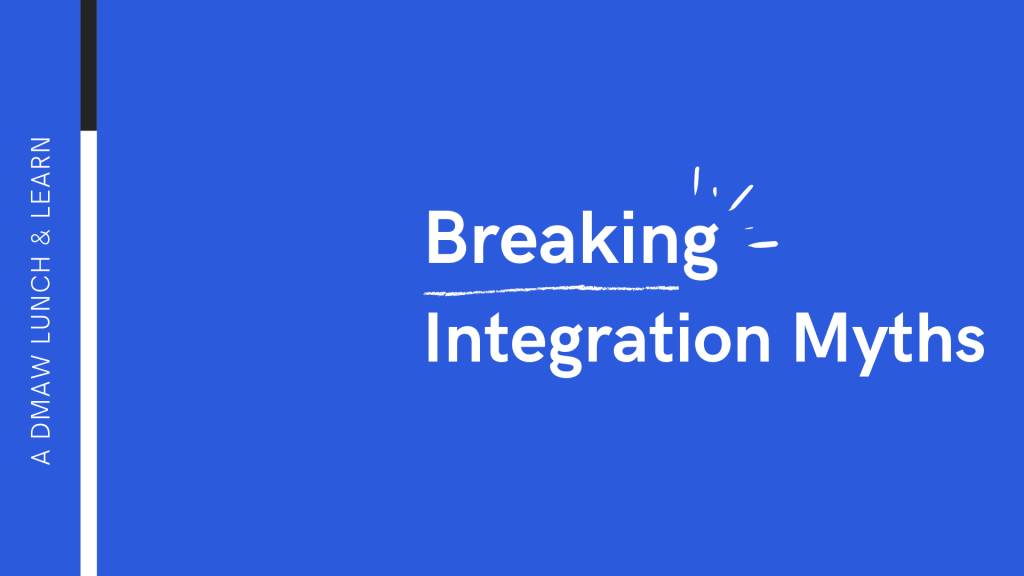Breaking Integration Myths

When it comes to food, people have long worked at breaking integration myths.
Take the myth that oils and waters can’t mix. It’s a myth that can be easily broken when you add an emulsifier (egg yolk), force (whisking), and technique (slowly pouring melted butter into lemon juice and water) to create a hollandaise sauce that never separates.
Or take a simpler example. Reese’s Peanut Butter Cups. Who can forget the classic ad campaign “Two great tastes that taste great together” that changed the entire world’s perception that chocolate and peanut butter can’t be paired together.
At this June’s DMAW Lunch and Learn, 40 marketing professionals gathered to eat and learn about the integration myths affecting our day-to-day fundraising campaigns that can be broken…specifically, those related to integrated, multi-channel marketing.
Our hosts for this great presentation were Stephanie Drahan, Sr. Account Exec at Mal Warwick Donordigital, and from the Democratic National Committee, Lauren Williams, Director of Direct Marketing and Clarke Humphrey, Director of Online Fundraising.
The program began with a simple question. Does multi-channel marketing equal integrated marketing?
The answer, of course, is no. Multi-channel only refers to the ability to deliver marketing on various platforms. Integrated aims to make these varied platforms more seamlessly work together for overall improved results.
Specific outcomes from integration can include higher response rates and lifetime value, the ability to readily pivot and enhance messages once they’ve dropped in the mail, and increased likelihood for donor upgrades.
In helping to build the case for increased integration, our presenters shared a case study that showed the effect integration had on donor retention at the DNC. When analyzing their digital and direct mail programs, the DNC found that even though the programs were not thoughtfully integrated donors who were present on both files had a higher retention rate and higher donor value. The DNC has since fully integrated the programs, restructuring their fundraising teams to allow for improved collaboration and implementation.
Tips that can help improve the results of integrated campaigns include the sharing of graphics and copy between channels. For example, at the DNC, they replicated the image of the membership card sent to donors via mail into a chase email, which reminded donors to return the reply form sent with their mailing. They also provided the opportunity for digital-only donors to get a hard card mailed to them once a renewal gift was made.
The concept of sharing between channels should also followed when it comes to data. This is important as it can help ensure donors see more consistency in merge personalization, such as the ask strings donors see offline vs. online.
When analyzing the effectiveness of various channels in integrated campaigns, our presenters noted the importance of not misreading a low response in any one specific channel and being patient for offline returns.
At the DNC, for example, they found that while social ads produced limited response from the social ads themselves, those ads produced an overall higher response in offline channels.
An even better example of this was a campaign in which the DNC followed a renewal mailing with a peer-to-peer text. While the text itself only generated negligible direct revenue, when looking at results holistically, they found that the text messaged donors produced a higher response rate and significantly higher revenue when compared to a holdout portion of the file.
Stephanie also shared the results from another client who found that adding text into the marketing channel mix for a monthly sponsorship campaign produced TRIPLE the join rate of those that did not receive a text.
While it would take too long to list all of the great ideas that Stephanie, Lauren and Clarke shared in the rest of their presentation, there are a few more that are worth highlighting.
The first was a campaign for their teleconference town halls in which they increased participation from their previous robo-call only invites (limited to donors with land line) with the addition of a last minute peer-to-peer text that invited the majority of participants just 10 minutes before start time.
Another idea was to make sure you incorporate the USPS Informed Delivery service into your integrated campaigns. This service, which the USPS offers for a very low cost, replaces the photocopied mail piece recipients can anticipate in their mailbox in the next 24 hours with a full color image and opportunity to click, read and donate without even opening their mailbox. It can be a great additional touch, especially for those who may not be on your email file. Note: It’s still in “beta” so availability may be limited.
Finally, they noted that in digital advertising, ads work better together, specifically when you integrate the messaging between social and search.
For example, if your current Facebook ad says “Say goodbye to”, the top results people see when they search your brand name on Google or Bing should also include “Say goodbye to.” This can also be done in reverse, retargeting ads on Facebook with the same message viewed in your brand name search ad.

Mark Gould is the direct marketing director at AIPAC and can be reached at mgould@aipac.org.
